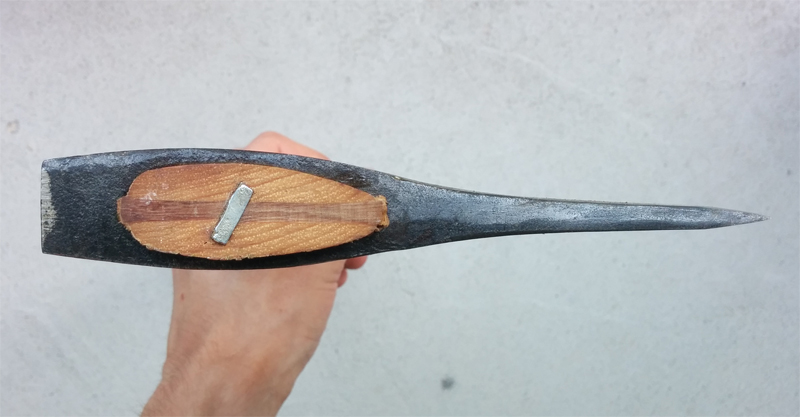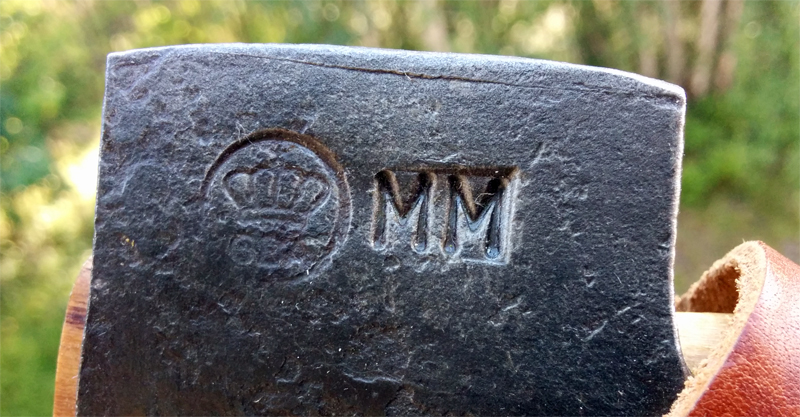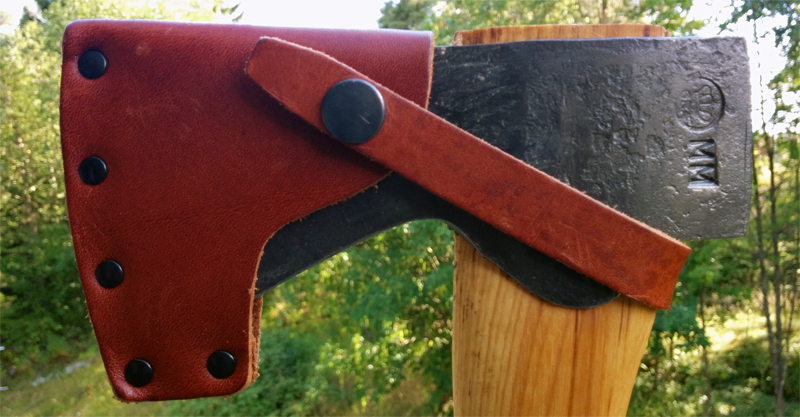One of the oldest of human tools, the axe has been used for countless millennia as a tool to shape, split and cut wood; and as a weapon to kill and maim animal and human alike.
Humans have gone from making axes out of of stone to making them out of copper, bronze, iron, and steel as technology has progressed.
Axe production has also gone from being a work of art to being something mass produced in a large factory by robots.
Not so with Gränsfors Bruks axes.
These axes are still forged by hand, by twelve master axe smiths, in a factory in the small village of Gränsfors in the middle of Sweden, and each approved axe head is stamped with the initials of the individual axe smith.
I’ve owned one of their Small Forest Axes for a couple of years now, and it is one of their allround axes that is designed to be used in the forest for everything from felling large trees to limbing small logs.
Gränsfors Bruk tells me that the family of Forest Axes are designed especially to cut across the grain of the wood fibres, for example when felling and limbing, rather than to split logs where the axe goes along the grain of the wood fibres.
Today you’ll get my honest opinion of this axe.
Performance – 8
I’ve used this axe many times in the woods during bushcraft adventures and for general camp work and I can tell you that it works very well for its intended purpose, and it’s really not that bad for splitting firewood either.
But rather than taking my word for it, I did some cutting tests on various pieces of wood that you can see in the below video (if you like it then subscribe to our channel, lots of videos in the pipeline).
The Small Forest Axe does as promised and cuts very well across the grain, both in bigger logs and smaller branches. This is what it’s built for, and it shows.
As far as splitting goes, you can see that splitting the firewood was no match for it either although it did get stuck the first try with the fresh piece of wood. That’s because the axe head is much thinner compared to a splitting axe that would force the wood apart.
 Small Forest Axe head shape
Small Forest Axe head shape
Construction Quality – 10
Just from holding the axe and using it in the woods I can tell it’s high quality workmanship, but let me tell you how they make these axes and you might get an idea of how much work goes into making one of these.
All Gränsfors Bruk’s axes start out as a square rod of carbon steel from the swedish steel company Ovako, and it’s a steel with a fairly high carbon content to supposedly make it an ideal steel for axe heads. Not too hard. Not too soft. “Lagom” as we’d say in swedish.
The steel is heated to 1200 degrees Celsius until it has a red-yellowish color, and then the axe smith takes the steel and works it in a big press (basically a gigantic hammer) that strikes the steel 80 times per minute with a force of 180 ton.
Slowly but surely the axe smith works the square steel rod into an axe head, and when he’s done and have approved it he stamps his initials into it and hangs it up for cooling. My axe was forged by “MM”, Mattias Mattson.
 Initials on my axe head
Initials on my axe head
After the forge it’s time to give the axe head a basic edge (the rest of the head is left as is, which gives it a really rough finish that I personally find attractive).
Once it has a basic edge the steel is hardened by heating it up to 820 degrees Celsius and then quickly cooling it in cold water. This makes the steel a lot harder but also brittle, so what they do next is they heat the steel in an oven for 60 minutes at 195 degrees Celsius, so called annealing. They do this to remove some of the stresses in the steel caused by the forging and hardening.
After all of this the axe head is tumbled with small ceramic balls to remove forging burrs on the surface of the axe and to make the axe more resistant to rust.
These axes take a pretty good beating in the quality control as well. After the tumbling every axe head is tested by striking on the edge’s corners with a hammer and checking that no cracking has occurred.
The final step in the axe head production is sharpening and polishing, and I can tell you by experience that these axes come delivered with a very sharp edge right out of the box.
As part of the last step the axe head is also dipped in a water-repellent and rust proofing oil, before being fitted with a Hickory-handle with the help of a hydraulic press.
Along with your axe you also get a minimalistic but very adequate leather sheath.
 Small Forest Axe with included leather sheath
Small Forest Axe with included leather sheath
Ease of Use – 8
As long as you keep the axe sharp it’s easy to use and pleasant to work with for light to medium cutting and even some splitting. You get a good grip on the handle and when you’re not using it you can easily stow it in your backpack or hang it on your belt using the leather sheath.
The low weight of only 0,9 kg (2 lb) makes this axe less than ideal for splitting firewood. For heavy splitting axes the weight and shape of the axe head provides a lot of the splitting power, but for the Small Forest Axe you’ll have to compensate with your own muscle power.
Maintenance – 8
You don’t have to do much maintenance to keep this axe in tip top shape year after year, but the few maintenance steps you should take are important yet fairly simple.
First off, you should store the Small Forest Axe in a cool and dry spot, because if it’s too warm the handle can shrink in the axe head. So, even though it’s a nice axe to look at I’d advise against hanging it on the wall over the fireplace.
Second, to prevent the axe head from rusting you can apply a thin coat of oil on the head after use. I use camellia oil myself, a japanese oil-blend used for centuries to keep Samurai swords in pristine shape. WD40 oil is a common choice of oil, but really any oil will do, even cooking oil or motor oil.
Third, to give the handle some love you can also apply a thin coat of oil every now and then, for example teak oil (note: will darken the handle) or boiled linseed oil (not the processed kind though!) diluted with turpentine.
Fourth, an axe with a dull edge is a dangerous axe so it’s in your best interest to keep it sharp. How to sharpen an axe is outside the range of this review, but you can find many good guides online, including on Gränsfors Bruk’s website.
Brand Reputation – 9
Gränsfors Bruk was founded in 1902 and in the 1920’s they started exporting axes all over the world, mostly to North and South America as well as Finland. Today their axes are sold in over 30 countries.
But interestingly enough, regarding brand reputation, from around the time of the oil crisis in the 1970’ and towards the end of the 1980’s many axe manufacturers focused on mass producing cheap axes, and the result was poor quality. Gränsfors Bruk was also guilty of that.
It wasn’t until the end of the 1980’s that the company decided to take a step back towards an older and more artful way of producing axes. You could say they decided to put more love into the making of their axes, and it paid off.
Other swedish axe manufactures such as Wetterlings and Hultafors followed suit, but Gränsfors Bruk was supposedly the first in once again placing quality before quantity. Kudos to them.
Guarantee – 9
Since 1995 Gränsfors Bruk has offered a 20 year guarantee on all of their axes, although it only applies to the axe head itself and not the Hickory handle or the leather sheath.
Furthermore, they have a disclaimer that the guarantee only applies as long as the axe is used and cared for properly… meaning if you leave your axe outside over the winter and it gets rusty and damaged then it’s your own fault. Makes sense.
Every axe is quality controlled by hand before it leaves the forge to make sure that there are no defects, so you can be fairly certain that your axe will live up to its promise. If not, a 20 year guarantee does give me comfort.
Sustainability – 7
Axe production requires quite a bit of energy, which is why swedish forges have usually been located along rivers to make use of abundant hydropower.
As mentioned Gränsfors Bruk gets all their steel from swedish steel manufacturer Ovako that produce their steel solely from recycled steel scrap.
Steel as a material can be reused any number of times without deterioration in its properties, and using recycled steel scrap means no new iron ore has to be mined for Ovako’s steel production.
While Ovako still relies on a rather wasteful industry for its one million tonnes of scrap every year they still get a gold star from me because of their relatively lower environmental impact.
Cheap oil is not a necessity in axe production, in fact as seen during the oil crisis in the 1970’s the demand for axes rose sharply and it became very profitable to manufacture and sell axes.
When the biggest competitor of the axe, the chainsaw, got expensive to run people turned to the axe, and that allowed companies such as Gränsfors Bruk to charge a higher price.
The bottom line is that axes will be around for a long time to come regardless of what happens to the oil price, and it’s a relatively sustainable tool compared to the chainsaw.
Self-Reliance – 8
If you’re an apartment dweller you may not have much use of an axe aside from staying alive during the zombie apocalypse (I estimate the risk of that happening to be fairly slim).
But if you life in a more rural area or spend time in the woods then an axe is a very useful tool.
Axes have been used for up to a million years (starting with stone axes) to build shelter and manufacture other tools, as well as to prepare food. Aside from the knife it’s one of the most versatile tools you can own, so it comes high up on the self-reliance scale.
And as long as you have something to sharpen it with you’ll be able to provide yourself with building material and firewood anywhere you have access to forest. That’s a big step up in self-reliance.
Value – 8
In Sweden this axe will set you back around $105, in the UK $125 (for example at Ray Mears Bushcraft), and in the US $120 (Grand Forest Inc. is the official US distributor).
So what other axe(s) can you get for $120 in the US?
Well, of similar size and weight you can get:
- roughly one Wetterlings Forest Axe at $143, or
- almost two Husqvarna Forest Axes at $75, or
- three Estwing Camper’s Axes at $40, or
- three Fiskars 7857 X15 Chopping Axe at $37, or
- four Cold Steel Trail Boss axes at $28.
So is the Gränsfors Bruks Small Forest Axe worth its price?
It totally depends on why you want an axe and what you’re going to use it for.
If you just want an axe for light use around the camp on your sporadic hikes or camping trips then you might be just as satisfied with an Estwing Camper’s Axe at a third of the price. Then you’d have plenty of budget left for a sharpening stone and even, if you don’t have one already, a good knife.
But if you plan to use your axe more frequently as I do, whether in the woods or around the home, then a higher quality axe is well worth the investment. Especially considering it can and likely will last you a lifetime when cared for properly.
And in case you would need to replace the handle on your Small Forest Axe years down the road then an original replacement handle will set you back around $30-35 in the US. But of course you could also fit the axe head with any other axe handle with a bit of tweaking.
Excitement – 7
There’s something timeless over the Gränsfors Bruks Small Forest Axe that I really like. This is an axe my great-grandfather would have approved of in the early 1900’s, and I would not be surprised if they still sell these axes 100 years from now using the same traditional methods.
The Small Forest Axe is not innovative in any way, but it’s quality workmanship. And sometimes taking a step back is better than stumbling forward.
Axe and saws are what built the New World, and something tells me that this tool might see a comeback as we build a more sustainable civilization.
Specifications
Length with handle: 50 cm (19”)
Weight: 1 kg (2.2 lb)
Axe head: High carbon steel
Handle: Hickory
Sheath: Vegetable-tanned leather
Origin: Sweden


